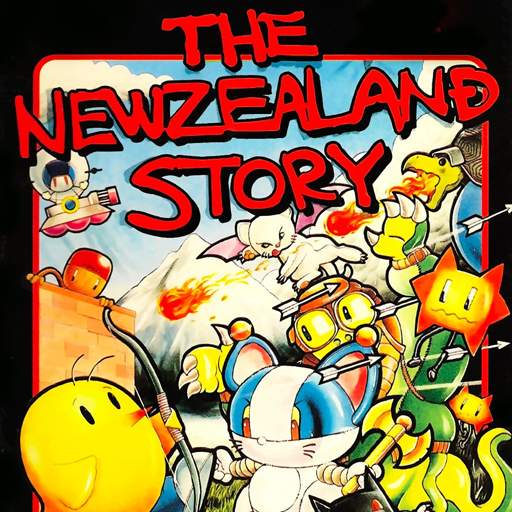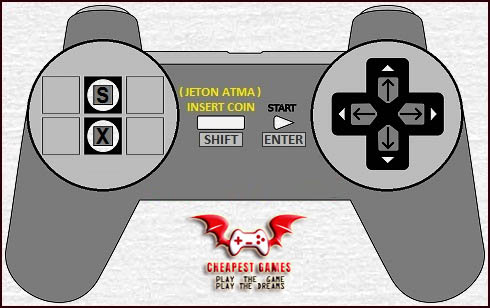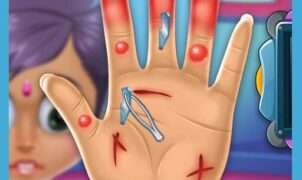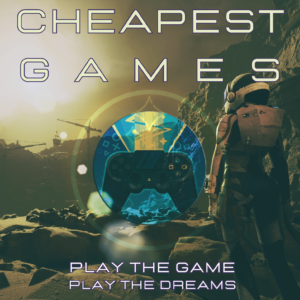
The NewZealand Story is a platform game developed and released in arcades by Taito in 1988. The concept and setting were inspired by a holiday trip in New Zealand by one of the Taito programmers. The player controls Tiki (ティキ), a kiwi who must save his girlfriend Phee Phee (ピューピュー) and several of his other kiwi chick friends who have been kidnapped by a large blue leopard seal. While avoiding enemies, the player has to navigate a scrolling maze-like level, at the end of which they release one of Tiki’s kiwi chick friends trapped in a cage. In 2007, the arcade game received a remake for the Nintendo DS under the title New Zealand Story Revolution.
Gameplay
The goal of each level is to safely get Tiki through the level, avoiding enemy fire and spikes (Tiki dies in one hit), and rescue one of his kiwi friends at the end. The weaponry starts out as an endless supply of arrows, but pickups can change these into bombs, lasers or bouncing fireballs. These act a little differently, and what is useful depends upon the player’s location. A distinctive feature of this game is the ability to ride a variety of flying vehicles, including balloons, blimps and UFOs. Vehicles can be found ready for use or can be stolen from an enemy.
The levels Tiki has to explore are quite expansive. Instead of single screen levels, they scroll along with the player and extend in all directions, encouraging the player to explore and navigate to find the exit and the many secrets hidden about the maze. On the lower left corner of the screen, there is a mini-map which shows Tiki’s position and the location of his caged kiwi friend, which is also the exit of each stage. Often, the vast size of the stages requires that Tiki get some means of transportation, often from enemies, to explore the stage and reach the exit. Though Tiki dies by enemies’ weapons and projectiles, he is not harmed by them directly.
The game features four main zones, each with four rounds, the fourth round featuring a boss fight at the end. Other features include the many secret areas and shortcuts hidden throughout the game, accessed using special hidden “warp” portals. On certain later levels, if the player loses their last life due to being killed by a projectile weapon, they will be sent up to a special “Heaven” round. Here, they can either receive a special ending or find the secret route out of Heaven and continue playing the game.
Each stage has an invisible time limit in which the player should take to reach the exit. If the player takes too long to find it, a jingle will play, accompanied by a “Hurry Up!” message. If enough time passes after the warning, an invincible little red devil will appear onscreen to chase down Tiki and kill him instantly if it catches up to him.
The game shares several elements with previous Taito games (such as collecting letters to spell out “EXTEND”, from Bubble Bobble).
Ports
After the release of the original arcade game in 1988, the game was converted to most of the game consoles and home computers of the time. Most home releases came in 1989, with some arriving later through 1990–1992. The home computer versions were published by Ocean Software, and their home computer versions refer to Wally as a walrus on the packaging; however, the original arcade version specifically mentions him as being a leopard seal during the closing credits. The NES version was developed by Software Creations and published in the PAL regions by Ocean. In North America the NES version was published by Taito as Kiwi Kraze. The game was included in the Amiga 500 Batman Pack, which was launched in September 1989 and sold over 2 million units. Home conversions generally received good reviews in video game magazines. The game was also converted for the Japanese FM Towns and X68000 systems, providing arcade-perfect conversions, but released exclusively in Japan since both computers were only available there.
In Japan, Game Machine listed The NewZealand Story on their November 15, 1988 issue as being the ninth most-successful table arcade unit of the month. In Europe, the arcade game received positive reviews from Computer and Video Games and The Games Machine.
The ZX Spectrum conversion of The NewZealand Story, published by Ocean in 1989, achieved critical success. CRASH awarded 91%, Your Sinclair 93% and Sinclair User 82%. On the conversion from arcade to an 8-bit platform, Your Sinclair accepted the “disappointing” monochrome display for the sake of smoother play. CRASH commented on the accuracy of the character graphics and animation describing it as “an arcade conversion masterpiece”, but found the multi-load cassette version to be awkward. The gameplay was deemed “addictive”, with the variety of weapons and modes of transport being particular highlights. By November, The NewZealand Story was number 2 in the Spectrum full-price games chart. The Spectrum version was voted number 34 in the Your Sinclair Readers’ Top 100 Games of All Time. The game was ranked the 19th best game of all time by Amiga Power. Mega placed the game at #40 in their Top Mega Drive Games of All Time.
The Nintendo DS remake Revolution received average critical reception. IGN awarded Revolution a “mediocre” score of 5.9, and Eurogamer gave 6/10. While reviews highlighted the challenging and fun retro gameplay, they criticized the touch-stylus and spot-the-difference events as poorly implemented, and the level design sometimes seen as spiteful.















